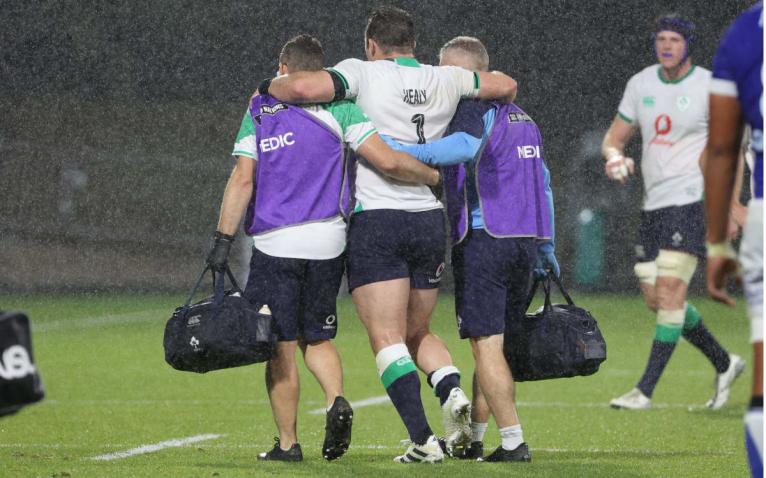It didn’t feel like a squad that Andy Farrell announced yesterday, more like a first draft of history. For if expectations are going to be lived up to, this 2023 World Cup will be remembered in Ireland forever, and so by extension will the names of those who played in it.
For context, Jack Charlton’s football team reached a quarter-final, the same ceiling Andy Farrell’s side are seeking to smash. They can. Even if history is against them, even if injuries have denied them the presence of Cian Healy, the veteran prop who can cover all three front-row positions, there is every reason why Ireland should travel to France with expectation rather than hope.
“We have evidence which gives us a bit of confidence,” said Sexton, “but we also know that it is the toughest group we have ever had, the toughest quarter-final draw if we manage to get through the group. So it is all to do.”

The pack alone contains Jeremy Loughman, Tom O’Toole and Joe McCarthy, who often are second choice with their provinces. Yet they are included by Farrell for a reason, Loughman because of Healy’s injury primarily, but also because he, along with O’Toole and McCarthy, left a deep impression on Farrell on last year’s tour to New Zealand.
Farrell’s mission in New Zealand, he repeatedly said, wasn’t just to get results but also to find characters, hoping to see if five uncut gems could be unearthed.
That was a tour filled with challenges, a five-match itinerary packed into three weeks, injuries mounting right through it. “That’s life, isn’t it,” Farrell constantly said. “I want to see what we are made of, how we react to challenges.”
His mission, he repeatedly said, wasn’t just to get results but also to find characters, hoping to see if five uncut gems could be unearthed. It’s interesting that O’Toole, McCarthy, Loughman, Craig Casey and Jimmy O’Brien are in this squad now, because they were his dirt trackers, lining out against the New Zealand Maoris on filthy nights in Wellington and Hamilton, when the stands were empty and the rain beat down.
Yet they never complained.
And this is their reward.

So even if Ulster often prefer Marty Moore to O’Toole, if Loughman, Casey and McCarthy have spent meaningful time on provincial benches rather than starting XVs, their presence in the squad is not going to lead to demonstrations.
We’re talking about the battle to be third choice, the right to be back-up to the back-up. With the exception of Jacob Stockdale and Joey Carbery, whose omissions stem from loss of form, there aren’t any cause célèbres.
The 2015 World Cup quarter-final defeat to Argentina exposed a lack of depth and led to a complete reevaluation of how Irish teams were going to prepare from thereon in. Regarded as a conservative selector, Joe Schmidt – Farrell’s predecessor – proved, in the last four years of his tenure, to be a risk-taker.
Still, it was an interesting selection.

And the seeds of that investment are visible now. Sixteen of Farrell’s squad earned their first caps under Schmidt and yet this is not Joe’s team. Rather it is a upgraded model of what he produced, Farrell retaining much of the ruck-obsessed detail which defined the Schmidt sides, while proving to be a more relaxed man-manager.
The Englishman has never been shy to promote players who aren’t first choice with their provinces – Jamison Gibson-Park being the most obvious example of that, but also Byrne, O’Toole, Loughman, Casey.
Significantly he also advanced Dan Sheehan’s case before the world knew what Sheehan could do. Now look at him, the world’s best hooker, arguably Ireland’s best player.
An injury to Furlong wouldn’t result in Farrell turning to a journeyman like Nathan White, Mike Ross’s back-up in 2015. O’Toole and Finlay Bealham have proved their worth in the last 12 months.

They dream of something big. And it can happen. The only trouble is the Springboks, All Blacks and French share the same dream. Two of this quartet will be home by the quarter-finals. Will that be Ireland once again? Not this time.
Ireland squad: Forwards Ryan Baird, Finlay Bealham, Tadhg Beirne, Jack Conan, Caelan Doris, Tadhg Furlong, Iain Henderson, Rob Herring, Ronan Kelleher, Dave Kilcoyne, Jeremy Loughman, Joe McCarthy, Peter O’Mahony, Tom O’Toole, Andrew Porter, James Ryan, Dan Sheehan, Josh van der Flier. Backs Bundee Aki, Ross Byrne, Craig Casey, Jack Crowley, Keith Earls, Jamison Gibson-Park, Mack Hansen, Robbie Henshaw, Hugo Keenan, James Lowe, Stuart McCloskey, Conor Murray, Jimmy O’Brien, Garry Ringrose, Johnny Sexton (Leinster, capt).


Ireland have the firepower to win this RWC. question is, can they beat the Boks, France or ABs, one after the other, week after week, without sustaining injuries or these other teams decoding their tactics and figuring out how to get one over them? If they pass the QFs it’s their tournament to lose. The only team I reckon may give Ireland trouble is SA, that pool match will be telling how either team will make out in the QFs.
Weird article for the outsider, “success won’t happen with journeymen” yet a key part of the article is about selecting 5 journeyman that fill out the squad without trouble?
Some how they are different to previous journeymen?
They peaked one year too early I reckon.
No chance but God loves a trier. The only question ❓ would be if they won because France, SA, NZ choked would the victory parade be in Dublin or Sydney?